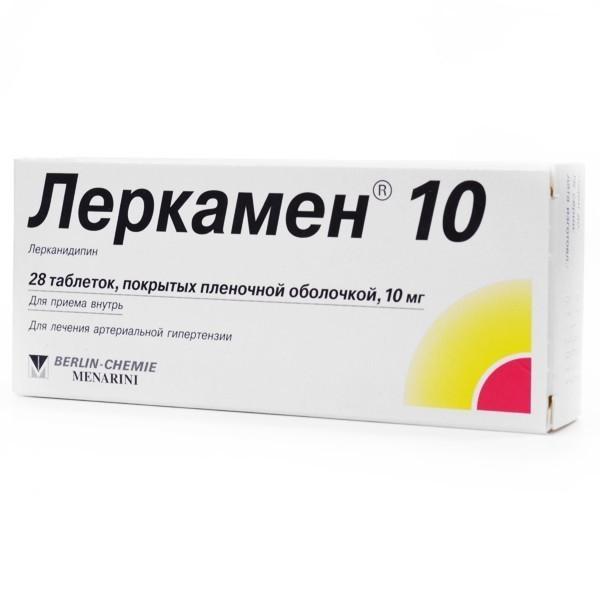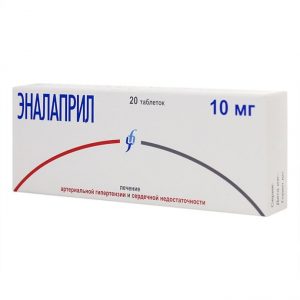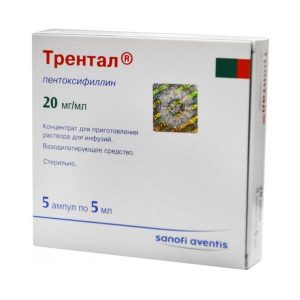Description
Release form
Film-coated tablets.
packaging 28 pcs
Pharmacological action
Pharmacodynamics
Selective blocker of slow calcium channels with a primary effect on blood vessels, a derivative of dihydropyridine. It inhibits the transmembrane current of calcium ions into the smooth muscle cells of blood vessels. The mechanism of the antihypertensive effect of lercanidipine is due to the direct relaxing effect on vascular smooth muscle cells, resulting in a decrease in OPS.
Despite the relatively short half-life from plasma, lercanidipine has a prolonged antihypertensive effect due to the high coefficient of membrane distribution. Due to the high vascular selectivity does not have a negative inotropic effect. Acute arterial hypotension with reflex tachycardia rarely occurs due to the gradual development of vasodilation with lercanidipine.
Lercanidipine is a racemic mixture of (+) R and (-) S enantiomers. The antihypertensive effect of lercanidipine is primarily due to the S-enantiomer.
Duration of therapeutic effect – 24 hours.
Pharmacokinetics
Absorption
Lercanidipine is completely absorbed after oral administration. Cmax in blood plasma is reached after 1.5-3 hours and is 3.3 ± 2.09 ng / ml and 7.66 ± 5, When taking lercanidipine no later than 2 hours after ingestion of fatty foods, its bioavailability increases by 4 times, therefore, Lerkamen ® should not be taken after meals. With oral administration of lercanidipine, its concentration in blood plasma is not directly proportional to the dose taken (nonlinear kinetics). The saturation of the presystemic metabolism occurs gradually. Thus, bioavailability increases with increasing dose.
Distribution
Distribution from blood plasma to tissues and organs occurs quickly and extensively. Plasma protein binding exceeds 98%.
Metabolism and excretion of
Lercanidipine is metabolized by the CYP3A4 isoenzyme to form inactive metabolites.
About 50% of the dose taken is excreted by the kidneys (about 50% is excreted by the intestines). Elimination occurs mainly through biotransformation. The average T1 / 2 is 8-10 hours.
Cumulation of lercanidipine with repeated ingestion is not observed.
Pharmacokinetics in special clinical cases
The pharmacokinetics of lercanidipine in elderly patients, patients with renal insufficiency (CC more than 30 ml / min) and in patients with mild and moderate hepatic insufficiency has been shown to be similar to the pharmacokinetics observed in the general population patients.
In patients with renal failure (CC less than 30 ml / min) and in patients on hemodialysis, plasma concentrations of lercanidipine were higher (approximately 70%).
In patients with severe renal and / or liver failure due to a decrease in plasma protein concentration, the free fraction of lercanidipine may increase.
In patients with moderate to severe hepatic insufficiency, the systemic bioavailability of lercanidipine is likely to increase, since lercanidipine is metabolized primarily in the liver.
Indications
Essential hypertension I-II severity.
Contraindications
Hypersensitivity to other derivatives of the dihydropyridine series
untreated heart failure
unstable angina
vascular obstruction, outgoing from the left ventricle of the heart
period within 1 month after myocardial infarction
severe hepatic insufficiency
severe renal failure (KK less than 30 ml / min)
simultaneous use with CYP3A4 inhibitors (ketoconazole, itraconol, erythromycin, erythromycin, erythromycin) simultaneous use with cyclosporine
simultaneous administration with
grapefruit juice lactose intolerance, lactase deficiency, glucose-galactose malabsorption syndrome
pregnancy and lactation (gr feeding-stand)
use in women of childbearing age who are not using reliable methods of contraception
childhood and adolescence to 18 years (effectiveness and safety have not been studied)
hypersensitivity to the drug.
Caution should be used: in renal (CC more than 30 ml / min) and / or hepatic insufficiency of mild to moderate severity, in elderly patients, in CVS (without pacemaker), coronary heart disease, left ventricular dysfunction.
Composition
1 tablet contains:
Active substances:
lercanidipine hydrochloride 10 mg.
Excipients:
lactose monohydrate – 30 mg,
microcrystalline cellulose – 39 mg,
sodium carboxymethyl starch (type A) – 15.5 mg,
povidone K30 – 4.5 mg,
magnesium stearate – 1 mg.
Shell composition:
opadray OY-SR-6497 – 3 mg (hypromellose – 1.913 mg, macrogol 6000 – 0.3 mg, talc – 0.15 mg, titanium dioxide – 0.6 mg, iron dye yellow oxide – 0.037 mg )
Dosage and administration
The drug is taken orally, at least 15 minutes before a meal, preferably in the morning, without chewing, with plenty of water.
Assign 10 mg 1 time / day. Depending on the individual tolerance of the drug by the patient, the dose may be increased to 20 mg.
Therapeutic dose is selected gradually, because maximum antihypertensive effect develops approximately 2 weeks after the start of the drug. It is unlikely that the effectiveness of the drug will increase with increasing doses of more than 20 mg / day, at the same time, the risk of side effects increases.
Pharmacokinetic profile and clinical trial data show that elderly patients do not require dose adjustment of Lerkamen ®. However, caution should be exercised at the initial stage of treatment with Lerkamen ® in this group of patients.
Caution should be exercised when using Lerkamen ® in patients with mild to moderate renal and hepatic insufficiency.
In case of renal failure (CC more than 30 ml / min) or liver failure of mild or moderate severity, the initial dose is 10 mg, then with caution increase the dose to 20 mg / day.
The antihypertensive effect may be enhanced in patients with mild or moderate hepatic insufficiency and dose adjustment (reduction) may be required.
In case of renal failure (CC less than 30 ml / min) and severe liver failure, the use of Lerkamen ® is contraindicated.
Drug Interaction
Lercanidipine can be used concurrently with beta blockers, diuretics, ACE inhibitors.
When used with metoprolol, the bioavailability of lercanidipine is reduced by 50%. This effect may occur when used with other beta-blockers, so it may be necessary to adjust the dose of lercanidipine to achieve a therapeutic effect with this combination.
Lercanidipine is metabolized by the CYP3A4 isoenzyme, so inhibitors and inducers of this isoenzyme are co-administered, may affect the metabolism and elimination of lercanidipine.
Concomitant use of lercanidipine with CYP3A4 inhibitors (ketoconazole, itraconazole, ritonavir, erythromycin, troleandomycin) is not recommended.
Concomitant use of cyclosporine and lercanidipine is not recommended since there is an increase in the concentration of both substances in the blood plasma.
Caution should be exercised when lercanidipine is co-administered with other CYP3A4 substrates (terfenadine, astemizole, class III antiarrhythmic drugs, such as amiodarone, quinidine).
When lercanidipine is administered at 20 mg with midazolam, the bioavailability of lercanidipine in elderly patients may increase by approximately 40%.
Lercanidipine should be administered with caution in conjunction with CYP3A4 inducers, e.g. anticonvulsants (phenytoin, carbamazepine) and rifampicin as the antihypertensive effect of the drug may be reduced. Regular blood pressure monitoring is required.
No pharmacokinetic interaction was observed with concomitant administration of lercanidipine at a dose of 20 mg in patients receiving permanent beta-methyldigoxin, whereas in healthy volunteers treated with digoxin, there was a 33% increase in Cmax for digoxin uptake by an average of 20% mg of lercanidipine on an empty stomach, with AUC and renal clearance varying slightly. The signs of digoxin intoxication in patients receiving both digoxin and lercanidipine should be monitored.
Concomitant use of lercanidipine with cimetidine (up to 800 mg) does not cause significant changes in the concentration of lercanidipine in blood plasma. At high doses of cimetidine, bioavailability and the antihypertensive effect of lercanidipine may be increased.
When lercanidipine (20 mg) and simvastatin (40 mg) were co-administered, the AUC for simvastatin was increased by 56%, and the same value for its active metabolite – -hydroxy acid – by 28%. When taking drugs at different times of day (lercanidipine – in the morning, simvastatin – in the evening), you can avoid unwanted interaction.
No changes in warfarin pharmacokinetics were observed with lercanidipine co-administered with 20 mg and warfarin in healthy volunteers.
Co-administration with fluoxetine (a CYP2D6 and CYP3A4 inhibitor) in elderly patients did not have clinically relevant changes in the pharmacokinetics of lercanidipine.
It is possible to increase the antihypertensive effect while taking grapefruit juice and lercanidipine.
Ethanol can potentiate the antihypertensive effect of lercanidipine.
overdose Presumably, in the case of lercanidipine overdose, symptoms similar to those of overdosage of other dihydropyridine derivatives will be observed: peripheral vasodilation with marked BP and reflex tachycardia.
Treatment: carrying out symptomatic therapy in case of marked decrease in blood pressure, loss of consciousness cardiovascular therapy is shown, in bradycardia – in / in the introduction of atropine.
There are 3 cases of overdose with lercanidipine 150 mg, 280 mg and 800 mg for suicide.
Drowsiness was observed when taking 150 mg of lercanidipine + alcohol (unspecified amount).
Treatment: gastric lavage, activated charcoal intake.
The following symptoms were observed with 280 mg of lercanidipine + 5.6 mg of moxonidine: cardiogenic shock, severe myocardial ischemia, mild renal failure.
Treatment: cardiac glycosides, diuretics (furosemide), high doses of catecholamines, plasma substitutes. In the case of 800 mg of lercanidipine, nausea and marked decrease in blood pressure were observed.
Treatment: administration of activated charcoal and laxative, in / in – dopamine.
In all cases of overdose, all patients remained alive. There is no information on the effectiveness of dialysis for lercanidipine. Most likely, due to the high association of lercanidipine with blood plasma proteins, dialysis may be ineffective.
Storage conditions
Keep out of the reach of children at a temperature not exceeding 30 ° C.
The Expiration of
is 3 years.
Deystvuyuschee substances
Lerkanydypyn
Conditions of supply of
Pharmacy Prescription
dosage form
dosage form
tablets
Berlin-Chemie / Menarini, Germany




